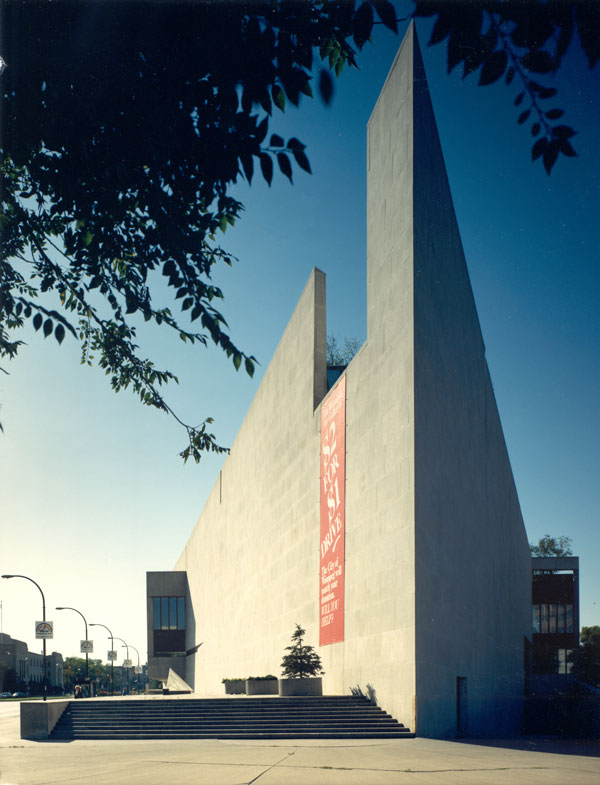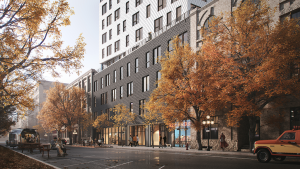Winnipeg is fortunate to have many examples of different styles of architecture, including one called Brutalist.
Although a few have met the wrecking ball, most examples of Brutalism in Winnipeg are still standing, one of the benefits of being a slow-growth city.
Jeffrey Thorsteinson, a Winnipeg architectural historian, says most Brutalist structures have in common “the conspicuous use of bare concrete, especially that which bears the impression of the wooden forms used in construction.”
In French, such bare concrete was called bêton brut (“concrete in the raw”) and the name stuck.
One of the first proponents of Brutalism was the Swiss-French architect known as Le Corbusier.
He became known in the 1940s and 1950s for designing buildings in Europe that were heavy, rough and unfinished.
Thorsteinson says another home of early Brutalism was the United Kingdom, where it was called “the new Brutalism.”
“It was a younger generation’s rejection of the older generation of British Modernists’ perceived shift toward decorative and picturesque approaches,” says Thorsteinson.

Helen Goodland, head of research and innovation at Scius Advisory, a Vancouver consulting firm, studied architecture in the U.K. She says the British architects who espoused Brutalism wanted to make a strong statement as they designed public housing projects in cities that had been heavily damaged by German bombing in the Second World War.
“Unlike Canada, the greatest examples of British Brutalism were residential,” says Goodland. “The premise of Brutalist architects in Britain is that form should be determined by function, without the embellishments and ornamentation of earlier styles.”
By the late 1960s and early 1970s, examples of Brutalism could be found all over the world, including Canada.
“Brutalism in Canada was often associated with large-scale, institutional projects related to the arts and academia,” says Thorsteinson. “In Canada there is Montreal’s Place Bonaventure (1967), Charlottetown’s Confederation Centre of the Arts (1964) and Ottawa’s National Art Centre (1969).”
Winnipeg has a number of excellent Brutalist buildings, says Susan Algie, director of the Winnipeg Architecture Foundation.
A few examples are the Royal Manitoba Theatre Centre, Robson Hall, Lion’s Manor and the Canadian Grain Commission Building.
In addition to Brutalism, Winnipeg has a wide variety of buildings from different architectural periods, which makes the city “rather unique” in Canada, says Algie.
“We have an excellent collection of Edwardian and Victorian buildings, Richardsonian Romanesque in the Exchange District, Modernist buildings and some great examples of the International style,” says Algie.
In its early days, Winnipeg was the gateway to the west and there was a great deal of new construction.
“Architects came to Winnipeg from all over the world and they brought their ideas with them,” says Algie. “After the Panama Canal was built, which reduced Winnipeg’s importance as a manufacturing and warehousing centre, there was a slowdown in building in the city, and no pressure to demolish what had been constructed, especially in the Exchange District.”
After the end of the Second World War there was another economic growth spurt, a time when many Modernist and Brutalist buildings were constructed.

“Many of them were designed by young architects who had been trained at the University of Manitoba,” says Algie.
Like an earlier period in Winnipeg, post-war economic activity was followed by another slowdown, and the windfall benefit that few buildings in the city had to bite dust.
What makes Winnipeg Brutalism unique is its use of Tyndall stone, a type of limestone found on the eastern Prairies.
“Tyndall stone has been used in Manitoba since the 19th century,” says Thorsteinson. “It was used to build Lower Fort Garry (1830) and St. Andrews-on-the-Red Church (1845-49).”
In the first half of the 20th century, Tyndall stone was used in the construction of the Manitoba Legislative Building (1920) and the Winnipeg Auditorium (1931-32).
Post-World War Two examples include City Hall, the Manitoba Museum, Centennial Concert Hall and the Duff Roblin Building.
Although examples of the style can be seen almost everywhere, Brutalist- style buildings are some of the least liked and least understood of all architectural styles, says Thorsteinson.
“Often they were built for functions, such as jails, that stimulate negative feelings about the buildings,” he says.
Sasa Radulovic, founding partner of 5468796 Architecture Inc., says Brutalist architecture is like modern art, which emphasizes texture, shadows and scale.
“Brutalism is challenging and interesting, but it’s not warm,” says Radulovic.
Algie says, “We offer tours, talks, films and exhibits to educate people about Brutalist architecture and why it shouldn’t be hated. The Royal Manitoba Theatre Centre is a very loved cultural resource in Winnipeg and has been impactful in changing people’s opinions.”





Recent Comments
comments for this post are closed